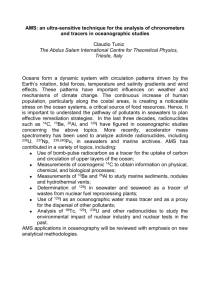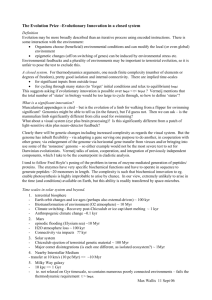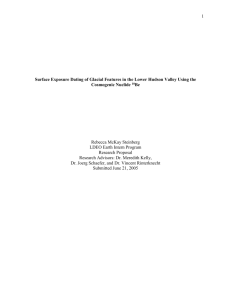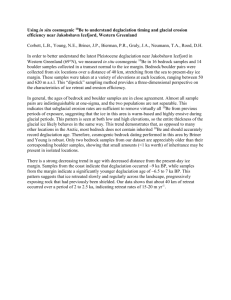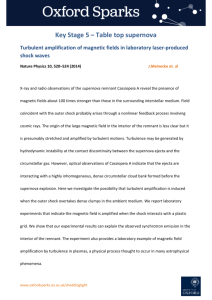Gordon Research Conference 2011
advertisement
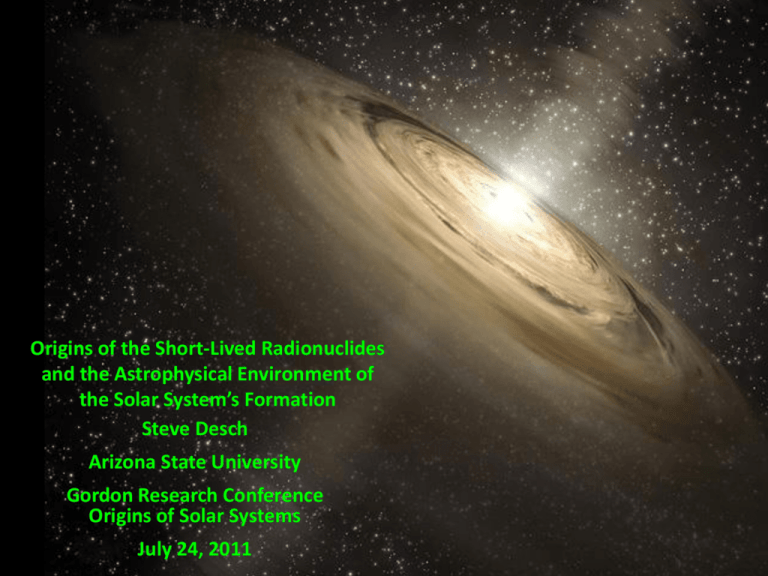
Origins of the Short-Lived Radionuclides and the Astrophysical Environment of the Solar System’s Formation Steve Desch Arizona State University Gordon Research Conference Origins of Solar Systems July 24, 2011 Isotopic analyses of meteorites reveal the onetime presence of many short-lived radionuclides: 10B 11Be (Wadhwa et al. 2007) 41Ca t1/2 = 0.10 Myr 41Ca/40Ca = 10B 11Be y = y0 ≈ 1.5 x 10-8 0 + 10Be 9Be + m x 9Be 11Be x Srinivasan et al. (1994; 1996) 36Cl t1/2 = 0.30 Myr 36Cl/35Cl ≈ 5 - 17 x 10-6 Lin et al.(2005), Jacobsen et al.(2011) 26Al 10Be t1/2 = 0.71 Myr 26Al/27Al t1/2 = 1.51 Myr 10Be/9Be ≈ 5 x 10-5 Lee et al. (1976); MacPherson et al. (1995) ≈ 10-3 10B 11B 9Be / 11B McKeegan et al. (2000), etc. 60Fe t1/2 = 2.6 Myr 60Fe/56Fe ≈ 3 x 10-6 Tachibana & Huss (2003) 53Mn t1/2 = 3.7 Myr 53Mn/55Mn ≈ 1 x 10-5 Lugmair & Shukolyukov (1998) 107Pd 182Hf 129I t1/2 = 6.5 Myr t1/2 = 8.9 Myr t1/2 = 15.7 Myr 107Pd/108Pd ≈ 5-40 x 10-5 Chen & Wasserburg (1996); Carlson180 & Hauri (2001) -4 182 Hf/ Hf ≈ 1 x 10 Kleine et al. (2002, 2005); YinI/ et127 al.I(2002) 129 ≈ 1 x 10-4 Swindle & Podosek (1998) Multiple minerals within a single inclusion (like this CAI), with different Be/B ratios, are measured Isotopic analyses of meteorites reveal the one-time presence of many short-lived radionuclides (SLRs): (Wadhwa et al. 2007) 41Ca t1/2 = 0.10 Myr 36Cl t1/2 = 0.30 Myr 26Al t1/2 = 0.71 Myr 10Be t1/2 = 1.51 Myr These 3 nuclei have 3 different origins 60Fe: injection. Neutron-rich. 36Cl: irradiation. Present only in late-stage alteration Not produced significantly by spallation; requires stellar nucleosynthesis. Only remotely likely source is core collapse supernova(e). Levels consistent with nearby supernova in same star-forming region. 60Fe t1/2 = 2.6 Myr products. Very short half-life. Levels too high too have been injected by supernova or inherited from molecular cloud. 53Mn t1/2 = 3.7 Myr 10Be: 107Pd t1/2 = 6.5 Myr 182Hf t1/2 = 8.9 Myr including CAIs and hibonite grains, first to form. Ubiquitous and uniform. Not produced by stellar nucleosynthesis. Levels consistent with 10Be cosmic rays trapped in molecular cloud (Desch et al. 2004), although this is debated (but keep watching). 129I t1/2 = 15.7 Myr inheritance. Present in a wide variety of samples, 107Pd, 182Hf, 129I, probably inherited from ISM enriched in these SLRs by long-term Galactic nucleosynthesis (Harper 1996; Jacobsen 2005). Scenario #1: Desch et al. (2004); Ouellette et al. (2005, 2007, 2009, 2010); Hester et al. (2004); Hester & Desch (2005); Ellinger et al. (2009); Desch et al. (2010) Galactic cosmic rays enrich ISM: 10Be Irradiation at several AU: Radionuclides inherited from the molecular cloud 36Cl, 53Mn? Ongoing galactic nucleosynthesis enriches ISM: 129I, 182Hf, 107Pd ~ 1 local supernova injected radionuclides into molecular cloud or protoplanetary disk: 41Ca, 26Al, 60Fe, 53Mn?, 107Pd Scenario #2: Shu et al. (1996, 1997, 2001); Gounelle et al. (2001, 2006, 2009); Gounelle (2006); Gounelle & Meibom (2007, 2008). Irradiation at < 0.1 AU, followed by outward transport (X-wind): 41Ca, 36Cl, 26Al, 10Be, 53Mn Radionuclides inherited from the molecular cloud Ongoing galactic nucleosynthesis enriches ISM: ~ dozens of local supernovae injected radionuclides into Sun’s molecular cloud ~15 Myr before solar system forms (SPACE model): 129I, 182Hf, 107Pd, 53Mn? 60Fe, 53Mn?, The SLRs 41Ca, 36Cl, 10Be, 26Al and 53Mn can be produced in their observed proportions, incorporated into CAIs near the Sun, then ejected to 2-3 AU, a la the X-wind model (Gounelle et al. 2001). There is no need to invoke supernova injection for these SLRs (Gounelle 2006). The SLRs 41Ca, 36Cl, 10Be, 26Al and 53Mn can be produced in their observed proportions, incorporated into CAIs near the Sun, then ejected to 2-3 AU, a la the X-wind model (Gounelle et al. 2001). There is no need to invoke supernova injection for these SLRs (Gounelle 2006). The X-wind can’t make CAIs, and can’t produce those SLRs in the correct proportions. They require some other origin, especially 60Fe (Desch, Morris, Connolly & Boss 2010)! The X-wind model Shu et al. (1996, 2001) HH30: Krist et al. (2000) Desch et al. (2010) ApJ 725, 692, critiqued the X-wind model. They found several problems. Problem 1: Bipolar outflows often cited as support for X-winds, but observations show outflows launched at 0.5-1 AU, not < 0.1 AU (Bacciotti et al. 2002; Anderson 2003; Coffey et al. 2004, 2007; Woitas et al. 2005). Disk winds carry > 70% of outflow (Woitas et al. 2005). Problem 2: Observations show X point well inside where solids evaporate (Eisner et al. 2005). Shu et al. (1996) estimated T < 1200 K at X-point because they neglected accretional heating. With M > 2 x 10-7 M yr-1, T > 1440 K. OOPS! Problem 3: Solids do not fall out of funnel flow: they are entrained with gas all the way to the star unless already > 4 mm in diameter. "Ad hoc" factor F=0.01 not at all justified. Problem 4: If particles do fall out of funnel flow, their velocity relative to reconnection ring will be ~ tens of km/s, enough to shatter particles in the disk. Problem 5: Particles in reconnection ring feel dense, ~ 107 K plasma. Thermal sputtering (neglected by Shu) prevents particle growth. CAI atoms remain gas, are swept into star. Sputtering rate in 107 K plasma: OOPS! Jones et al. (1996) Problem 6: CAIs grow by recondensing rock vapor following big flares. Oxygen fugacity fO2 > 105 x solar, inconsistent with CAI oxygen barometers like Ti+3/Ti+4 ratios in fassaite & rhonite, and osbornite in CAIs (Beckett et al 1986; Krot et al. 2000; Meibom et al. 2007). Shu et al. (2001) Mg "X-wind = eXtra oXidizing" Ca,Al-bearing minerals in CAIs melt at lower T than Fe,Mg-silicates. They don't form these structures! Fe O Si Ca Al O Si (Simon et al. 2002) Problem 7: Energetic ions cannot produce 10Be, 26Al & 41Ca in right proportions. Ca does not sequester itself in "refractory core", so 41Ca overproduced. 10Be overproduced relative to 41Ca and 26Al by factors > 3, especially if 10Be is trapped GCRs (Desch et al. 2004). And 60Fe is underproduced by > 5 orders of magnitude (Leya et al. 2003; Gounelle 2006). Problem 8: Magnetocentrifugal outflows only launch material from > 2 scale heights from midplane (Wardle & Konigl 1993), but disk of CAIs & chondrules in reconnection ring < 1 / 25 times as thick. X-wind model doesn't explain lofting or calculate trajectories. Bottom line: Protostellar jets don’t necessarily mean X winds, X winds don’t make CAIs, and X winds don’t produce SLRs in right proportions. 10Be can only be produced by irradiation, not by supernovae. It may be a “smoking gun” for the X-wind model (Gounelle et al. 2001; Gounelle 2006). 10Be can only be produced by irradiation, not by supernovae. It may be a “smoking gun” for the X-wind model (Gounelle et al. 2001; Gounelle 2006). 10Be has other sources, especially 10Be Galactic cosmic rays trapped in our molecular cloud (Desch et al. 2004). The X-wind actually overproduces 10Be (Desch et al. 2004, 2010). Galactic Cosmic Rays (GCRs) = nuclei of ions accelerated to relativistic speeds: Mostly protons, ~10% alpha particles, heavier ions in roughly solar proportions. The fluxes and energy spectra of GCRs, including 10Be nuclei, have been measured by satellites (Webber et al. 2002; see Desch et al. 2004 and references therein). 10Be/H ratio is known… and is 106 x solar! (Spallations of ambient H on GCR O.) GCR fluxes scale with supernova rate, therefore star formation rate, which was x2.2 higher 4.5 Gyr ago (see multiple references in Desch et al. 2004). GCRs follow magnetic field lines, which bend in regions of star formation. Schleuning et al. (1998) Simulations by Desch & Mouschovias (2001) show how gas in a collapsing molecular cloud core drags in magnetic field lines. Magnetic field lines are concentrated in core, focusing GCRs inward. High-pitch angle GCRs are mirrored out of the cloud core. High-energy GCRs pass through the cloud core. Some cause spallations of local O to form 10Be. Low-energy 10Be GCRs are stopped by ionizations and trapped within the core. Desch, Connolly & Srinivasan (2004),ApJ 602, 528, calculated the rates of all these processes in a collapsing cloud core. Desch and Mouschovias (2001) and Desch et al. (2004) calculate S(t) and B(t) for different B fields. 30 μG collapses in 10 Myr, 5 μG collapses in 2 Myr. 10Be GCRs trapped in core 10Be produced by spallation Total 10Be / 9Be ratio. Numerical error in Desch et al (2004) overestimated stopping rate by x3. Should have found 10Be/9Be ≈ 6 x 10-4. Bottom line: GCRs provide molecular cloud with right amount of 10Be. Additional sources overproduce 10Be! Final 10Be/9Be ratio very insensitive to B field because it saturates in 10Be half-life (1.5 Myr). If 10Be comes from 10Be GCRs trapped in the Sun’s molecular cloud, 10Be/9Be should be uniform, but it’s not (Gounelle 2006). If 10Be comes from 10Be GCRs trapped in the Sun’s molecular cloud, 10Be/9Be should be uniform, but it’s not (Gounelle 2006). Yeah! We measured 5.3 ± 1.0 x 10-4 in hibonites (Liu et al. 2009, 2010), which is not consistent with 8.8 ± 0.6 x 10-4 in Allende CAI 3529-41 (Chaussidon et al. 2006)! If 10Be comes from 10Be GCRs trapped in the Sun’s molecular cloud, 10Be/9Be should be uniform, but it’s not (Gounelle 2006). Yeah! We measured 5.3 ± 1.0 x 10-4 in hibonites (Liu et al. 2009, 2010), which is not consistent with 8.8 ± 0.6 x 10-4 in Allende CAI 3529-41 (Chaussidon et al. 2006)! Actually, 10Be is uniform. Not all the data were analyzed correctly (Desch, Ogliore, Morris & Huss 2011, in prep) MacPherson et al. (2003) 10B 11Be = 9Be/11B 10B 11Be y = y0 0 + 10Be 9Be + m x 9Be 11Be x Slope = 5.75 ± 1.90 x 10-4 χν2 = 0.85 10B Goodness of fit tells you whether the assumption of an isochron is valid! 11B 9Be / 11B Chaussidon et al. (2006) 10B = 11Be 9Be/11B 10B 11Be y = y0 0 + 10Be 9Be + m x 9Be 11Be x The slope reported by Chaussidon et al. (2006), 8.8 ± 0.6 x 10-4, is incorrect, based on a wrong equal fit of all data points. Slope = 12.7 ± 0.78 x 10-4 χν2 = 29.8!! 10B Isochrons are meaningless if you can’t fit a line to the data!! 11B 9Be / 11B Many points have 10B/11B > 0.25 Our interpretation: B isotopes in Allende 3529-41 reflect overall trend of incorporating live 10Be, and variable contamination by spallogenic B Spallogenic B has 10B/11B ~ 0.40 Chondritic ratio Chaussidon et al. (2006) 10B/11B = 0.248 Isochron cannot be fit to the data. Murchison hibonites Leoville, Vigarano, Efremovka CAIs Axtel l FUN CAI Allende 3529-41 Allende CAIs There are 17 analyses of 16 different samples. They all cluster around an average value. Average value is close to 10Be/9Be ≈6 x 10-4. Murchison hibonites Leoville, Vigarano, Efremovka CAIs Axtel l FUN CAI Allende 3529-41 Allende CAIs Eliminating the two analyses with the worst fits to an isochron (Axtell 2771 FUN CAI, χν2 = 4.4, and Allende 3529-41, χν2 = 29.8) leaves 15 analyses with average 10Be/9Be = 6.3 x 10-4. All other analyses have χν2 ≤ 2.2 and are consistent with average at 2 sigma level (except Allende 3529-41, which is probably contaminated). Bottom line: No evidence for 10Be heterogeneity! There was also 7Be in the solar nebula, with t1/2 = 53 days (Chaussidon et al. 2006)! There was also 7Be in the solar nebula, with t1/2 = 53 days (Chaussidon et al. 2006)! That’s a smoking gun for irradiation in the solar nebula (Chaussidon & Gounelle 2007)! There was also 7Be in the solar nebula, with t1/2 = 53 days (Chaussidon et al. 2006)! That’s a smoking gun for irradiation in the solar nebula (Chaussidon & Gounelle 2007)! The evidence for 7Be was driven by model assumptions and probably contamination by spallogenic Li; there is no evidence for 7Be (Desch & Ouellette 2006). Chondritic ratio 7Li/6Li = 12.02 Many points have 7Li/6Li < < 12 Spallogenic Li has7Li/6Li ~ 2 The only evidence for live 7Be comes from the same CAI Allende 3529-41, analyzed by Chaussidon et al. (2006), which is probably contaminated. These data points are not the measured values; they have already been corrected for GCR spallation within Allende. A better correction yields lower slope. Best fit, done properly, is 7Li/6Li = (11.37 +/- 0.02) + (0.0092 +/- 0.0006) (9Be/6Li), χν2 = 17!! Slope is driven entirely by points with 9Be/6Li < 30, with subchondritic Li ratios; eliminating these yields fit 7Li/6Li = (11.80 +/- 0.07) + (0.0010 +/- 0.0012) (9Be/6Li), χν2 = 0.72. Bottom line: We interpret all variability in 7Li/6Li due to contamination, not 7Be. It’s not possible to inject 36Cl from a supernova along with 26Al and 41Ca, its levels are too high (Gounelle 2006; Jacobsen et al. 2011). 36Cl must be formed in the solar nebula. It’s not possible to inject 36Cl from a supernova along with 26Al and 41Ca, its levels are too high (Gounelle 2006; Jacobsen et al. 2011). 36Cl must be formed in the solar nebula. Yes, 36Cl must be produced in the solar nebula, but not in an X-wind (Desch et al. 2010). It probably formed by irradiation of ices in the disk during the transition disk stage (Jacobsen et al. 2011; Desch et al. 2011, in prep). Evidence for 36Cl found only in late-stage aqueous alteration products like sodalite (Lin et al. 2005) and wadalite (Matzel et al. 2010; Jacobsen et al. 2011), at levels up to 36Cl/35Cl ~ 1.7 x 10-5. Al-Mg age of wadalite is 2.6 Myr after CAIs. Injecting 36Cl and 26Al from same supernova requires 36Cl/35Cl ~ 7 x 10-3, higher than any supernova models predict. 36Cl must be produced by irradiation, but X-wind region is too hot for 36Cl or its targets (S, Cl, Ar, K) to condense. Irradiation must take place further out in disk. Courtesy Sasha Krot Jacobsen et al. (2011; ApJ) hypothesize irradiation of ices at a few AU in late stage of disk in which gas had thinned, followed by accretion of ices by carbonaceous chondrite parent bodies; predicted that (additional) 10Be should accompany 36Cl. Desch et al. (2011; LPSC) also hypothesize irradiation of ices in transition disk stage, predict spallogenic Li and B, and maybe 53Mn, should accompany 36Cl. Spitzer observations show 10-20% of observed disks are transitions disks like TW Hydrae and DM Tau (Williams & Cieza 2011). Disks probably spend 0.5 – 1 Myr in this stage, at ages 3-6 Myr. Column densities ~ 1 g cm-2, optically thin to energetic ions. Desch, Krot, Alexander & Allu Peddinti (2011; LPSC) modeled isotope production in transition disk, including new reaction 38Ar(p,ppn)36Cl. Very little mass is irradiated, but that which is sees no dilution. Preliminary Predictions: 36Cl/35Cl = 3 x 10-6 7Li/6Li = 9.2 53Mn/55Mn =2 x 10-5 10Be/9Be ~ 0.007 Of these, Cl, Li, Mn mobilized;10Be will precipitate before reaching interior Bottom Line: Late irradiation in a transition disk may explain 36Cl, as well as B and Li anomalies. Injection of 60Fe, 26Al and 41Ca into our protoplanetary disk would have noticeably altered the oxygen isotopic composition of the disk (Gounelle and Meibom 2007). Injection of 60Fe, 26Al and 41Ca into our protoplanetary disk would have noticeably altered the oxygen isotopic composition of the disk (Gounelle and Meibom 2007). If only supernova dust is injected, this is no problem at all (Ellinger et al. 2010). Ouellette et al. (2005, 2007, 2010) advanced the “aerogel” model in which ejecta are injected directly into the protoplanetary disk as dust grains. Ouellette et al. (2007) showed gas-phase ejecta are not injected (< 1% efficiency). Ouellette et al. (2010) showed that large supernova dust grains (diameters > 100 nm) are injected efficiently (up to 90%). If only condensible dust is injected, oxygen isotopic shifts are small. Corundum (Al2O3) grains only have M(26Al)/M(16O) = 1.08. If all 26Al is in corundum grains and only corundum grains are injected, Injection of dust alone leads to isotopic shifts << 1 permil, too small to be noticed. isotopic shifts < 0.001 per mil. Fraction of supernova ejecta that condenses into dust is hotly debated, as reviewed in Ouellette, Desch & Hester (2010) ApJ 711, 597. Observations of dust in high-z galaxies imply 0.1 – 1 M of dust per supernova (Morgan & Edmunds 2003). Dust in SN1987A formed ~ 2 years after explosion; only 10-4 M directly seen in IR. But emission was from optically thick (at 30 μm) clumps (Wooden et al. 1993). Ouellette et al. (2010) argued most supernova observations miss dust because it is in clumps, and SN1987A could have held up to 1 M of dust. Recent Herschel observations (Matsuura et al. 2011) have revealed 0.4 - 0.7 M of cold (T = 20 K) dust in SN 1987A, implying condensation efficiency ~ 30 – 60% In these clump models, P reaches 10-4 bar, 103 times higher than previously considered Fedkin et al. (2010) Many models (e.g., Kozasa et al. 2010) predict high condensation efficiencies, but still predict unobserved features, because they have ignored clumpiness. Ouellette et al. (2010) presented a model for P-T conditions in clumpy ejecta. P ≤ 10-6 bar yields graphite condensing before SiC, FeSi, metal… Clumpy ejecta pressures P ≥ 10-5 bar yields TiC, then SiC / FeSi / metal, then graphite. Same sequence observed by Croat et al. (2011 LPSC) in an Orgueil SN Fedkin et al. (2010) presolar grain!! Strong evidence that SN presolar grains condensed in clumps. Clumps enhance dust growth and hide dust emission… suggests supernova dust condenses more efficiently than thought. Meteorites and planetary materials have 54Cr anomalies due to incorporating different proportions of some 54Cr carrier (Qin et al 2010; Trinquier et al 2007). This carrier just discovered: presolar “nanospinels” < 100 nm in size, with 54Cr/52Cr 3.6 x solar (Dauphas et al. 2011), some up to 50 x solar (Qin et al. 2011). Must have been formed in a supernova. Dauphas et al. (2011), Qin et al. (2011) argues for late injection of these presolar grains. Larsen et al. (2011) find correlation between 54Cr anomalies and 26Mg excesses… nanospinels may also be the carrier of 26Al! Bottom line: Supernovae make abundant (~ 0.5 M) dust; at least half of condensible material condenses into dust. ~50% of 100nm dust can be injected into a protoplanetary disk (Ouellette et al. 2010). Relatively high percentage of 26Al and 60Fe, etc., can be injected as dust into disk. Injection of dust without gas will not significantly alter oxygen isotopic composition of solar nebula (Ellinger et al. 2010). But SLRs in CAIs like 26Al and 41Ca must be formed in situ... it’s not possible to inject SLRs from a supernova, within the first < 1 Myr, at the required levels (Gounelle and Meibom 2008). But SLRs in CAIs like 26Al and 41Ca must be formed in situ... it’s not possible to inject SLRs from a supernova, within the first < 1 Myr, at the required levels (Gounelle and Meibom 2008). And we know 60Fe requires a supernova origin. It is possible, with triggered star formation and clumpy supernova ejecta. Injection into disk has ~1% probability (Ouellette et al. 2010). Injection into molecular cloud also works and is likely (Pan et al. 2011, in prep). HST/K.Luhman Simple geometric arguments show that disk must be < 0.15 pc from (isotropically exploding) supernova to get 26Al/27Al > 5 x 10-5 (Ouellette et al. 2005; Looney et al. 2006). Thousands of protostars with disks lie < few x 0.1 pc from O stars in Orion Nebula… … but that star won’t explode for > 4 Myr. By the time it does, coevally formed disks won’t be young disks anymore! Some disks do lie < 1 pc from stars < 1 Myr from exploding, but they’re rare. Still, H II regions like NGC 6357 provide evidence for triggered star formation. O3If* star Pismis 24, already evolved off main sequence NGC 6357: Healy et al. (2004) O stars’ UV drives ionization fronts and shocks into molecular cloud, triggering star formation. Hester & Desch (2005) Combined Spitzer / HST survey of 2-Myr-old region NGC 2467 (Snider et al. 2009) and other H II regions (Snider PhD thesis, 2008) show protostars continue to form many Myr after O stars, and their locations are highly correlated with ionization fronts, indicating a triggered formation. Triggered star formation continues until most massive stars go supernova. Easily 30-50% of low-mass stars in H II regions are triggered by massive stars. ~ 10% form just < 1 Myr before supernova. NGC 2467: Snider et al. (2009) The problem is these disks are far from the O star. Ionization fronts advance ~ 0.5 – 1 km/s = 2 – 4 pc in 4 Myr. Stars that do form just before supernova are far away (>2 pc). Isotropic supernova ejecta too diluted to explain 26Al/27Al ratio (by a factor ~ 300). > 2 pc! Hester & Desch (2005) 4 pc But supernovae are NOT isotropic! Cassiopeia A, 300-year-old supernova remnant (X ray = NASA Chandra, optical = NASA HST; infrared = JPL) HST: Fesen & Morse At d ~ 2 pc from explosion center, HST resolves thousands of knots, each ~ 10-4 M, each ~ 0.1 – 1” (~ 1016 cm), probably formed by R-T instabilities during explosion. N ~ 3000 bullets of mass ~ 3 x 10-4 M each, expanding homologously with radius R = d / 300 (consistent with numerical simulations and observed clumps in SN1987A and Cas A) have filling fraction N πR2 / (4πd2) ~ 0.8% Only 0.8% of disks receive ejecta, but those that do get 120 times what they’d get if ejecta were isotropic, equivalent to being 11x closer. Bottom line: Disks at 2 pc can form and within 1 Myr receive sufficient ejecta to explain 26Al and 60Fe abundances… but only 0.1 - 1% of disks in H II region conform to this scenario. (But multiple supernovae may ameliorate problem somewhat) And the fact remains… 60Fe requires a supernova origin! Supernova bullet These same bullets colliding with the surrounding molecular cloud penetrate about 0.5 pc before stopping and mixing with cloud gas in channel with area ~ 0.02 pc2. Cloud area per bullet ~ 0.02 pc2. All molecular cloud cores on verge of collapse will be mixed with one ~10-4 M bullet of supernova ejecta from some zone in the progenitor. Multiple (~ 10) supernovae in H II region may lead each star to be mixed with ~10-3 M of supernova ejecta from ~10 zones in different supernovae. Work in progress. This may be how supernovae delivered 60Fe to solar system. 2-D Flash simulations by Pan, Scannapieco, Desch & Timmes (2011, in prep) 60Fe does require a supernova origin, but not a single nearby supernova. Contamination of the molecular cloud by dozens of supernovae over the previous 15 Myr (SPACE model) is sufficient (Gounelle et al. 2009). 60Fe does require a supernova origin, but not a single nearby supernova. Contamination of the molecular cloud by dozens of supernovae over the previous 15 Myr (SPACE model) is sufficient (Gounelle et al. 2009). The SPACE model overestimates the efficiency by which 60Fe is mixed into molecular clouds (Desch et al. 2010). And it overpredicts the 53Mn / 60Fe ratio by orders of magnitude! Lowdensity ISM Gounelle et al. (2009), SPACE (Supernova Propagation and Cloud Enhancement) model Molecular cloud 1 has ~ 3000 M, Molecular cloud 2 has ~ 8000 M Shocks from cloud 1 can’t cause contraction of a new molecular cloud 15 Myr later unless gas can cool. To get 60Fe/56Fe ~ 10-6 …this gas must be swept …to form new …and 60Fe mixed in in forming system… up and compressed… molecular clouds… with 100% efficiency This low-density gas is heated when shocked and can’t cool and compress… SPACE relies on a thermal instability to cool (Koyama & Inutsuka 2002; Audit & Hennebelle 2010) that works at shock speeds < 100 km/s and T < 104 K, not the 2000 km/s shock speeds and 107 K gas here. A problem recognized by Gounelle et al. (2009): supernovae produce too much 53Mn along with 60Fe. 60Fe produced in innermost 6 M, 53Mn in innermost 3 M. If all of the ejecta are mixed, 53Mn / 60Fe ~ 102 x higher than meteoritic ratio For a single supernova may not eject all its material: progenitors > 20 M often experience “fallback” of innermost few M (Umeda & Nomoto 2002, 2005; Nomoto et al. 2006; Tominaga et al. 2007), resolving the 53Mn / 60Fe problem (Takigawa et al. 2008). A disk or molecular cloud may receive a clump of supernova ejecta from one zone in the progenitor. SPACE model invokes 4-22 (average 12) supernovae and mixes all of their ejecta. They can’t all experience fallback. Bottom line: not clear how formation of new molecular clouds are triggered by massive stars; not clear how 60Fe is mixed into new clouds; not clear how to avoid mixing in too much 53Mn. Short-lived radionuclides are important probes of the Solar System’s formation environment. Multiple SLR origins are needed. 36Cl formed by irradiation in solar nebula. 60Fe came from 1 or dozens “nearby” and “recent” supernova(e). Conclusion: Scenario #1! 1. Sun’s molecular cloud already enriched with 107Pd, 182Hf, 129I… as it collapses, 10Be GCRs trapped in it. 2. Massive stars’ ionization fronts trigger formation of low-mass stars, including Sun. 3. Supernova injects 26Al, 41Ca, 53Mn, 60Fe into disk or cloud. 4. Irradiation in Sun’s transition disk, ~ 3 Myr later, creates 36Cl, spallogenic Li & B, maybe some 53Mn.
